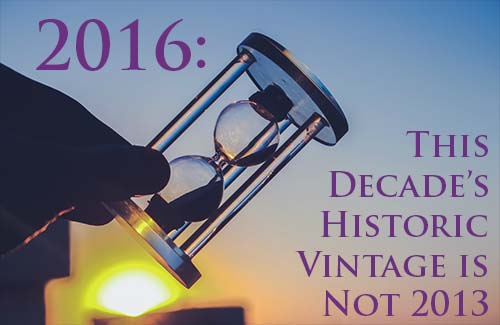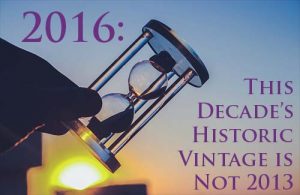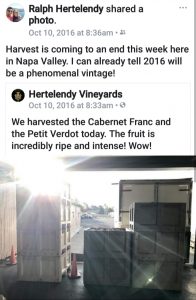|
As a Napa Valley vintner, I’m fortunate and blessed to have experienced amazing vintages almost every year. In my opinion, our prestigious older sibling Bordeaux arguably has two fantastic vintages in a decade (interestingly, over the past quarter century the year usually ended in a five or a zero) with eight vintages being “just okay.” Napa is the exact inverse with eight great vintages and two lackluster ones per decade. Mother Nature works in mysterious ways and has a lot to do with that. For example, not even the most amazing winemaker can make an incredible wine during a lousy vintage taste better than a great wine during a historic vintage. A lot of winemaking is out of our control…so what’s the secret formula for a vintage to achieve notable stardom? People have incessantly argued with me on vintages (I welcome the fun subjective banter!), and the difference is that no one will truly know about a vintage until they’ve experienced decades of multitudinous wine tastings. For instance, 2007 was a tremendous vintage in Napa––deemed the vintage of that decade––with high yields, densely ripe fruit, and superior quality. There was a drought in 2007, very little rain, and the weather was constantly temperate with very few 90+ degree days. Reminiscing on that vintage, the wines were generally extraordinary right out the gate, but they peaked within the first six years (zenith being years 2-4), and then they fell into their raisination mode in year 7+. I’m now avoiding 2007’s, hoping they escape their excessively sweet overtones and eventually blossom into their balanced delicate softness that I know they’ll achieve—probably in a few more years. The first time I ever received my first epiphany “aha moment” from a wine was with a 2007 Napa Valley Cabernet. When it was first tasted in 2009, it had boldness, elegance, ripe dark fruits, rich structure, balanced acidity, soft, supple tannins, and a long, lingering coffee finish. This Cabernet was a blend of mountain fruit and valley floor fruit, and contained a phenomenal complexity that continually evolved for hours. It was so mind-bending that I didn’t want to finish the bottle; very small sips were taken savoring every moment of that experience, and when the last droplet was poured, exotic summer-ripe rich apricot and dark plum stone fruit notes were dominating the flavor profile. I remember thinking exactly at that moment, “I wish right now that this was the starting point, not the ending.” Fast forward about seven years and this Cinderella story turns into a Nightmare on Elm Street. In December 2016, I proposed to my wife, Lauren, in Hawaii and she luckily said yes (that’s not the nightmare part!). I wanted to revisit this phenomenal wine with her while we celebrated. Unfortunately, we were both highly disappointed, receiving excessively sweet notes of raisins and molasses. It was nothing like I had remembered it, and not only did another “aha moment” not happen, we didn’t even finish half of the bottle. Only the overly extracted, tannic mountainous wines have prevailed and conquered the aging game. These same wines that I avoided during their first five years due to face-puckering tartness and heavy tannins are tasting very nice right now. The 2013 vintage was hailed as the famous vintage of this decade paralleling the formidable 2007 vintage. Perhaps it’s because 2011 had the most rainfall in 30+ years and once 2012 arrived, everyone said it was a great vintage because of the stark contrast. Then ’13 waltzed in, and easily outshone ’12; ’13 wasn’t as rigid and conservative, it was more approachable, balanced, riper, and showed young potential. 2013 was also another drought year, and temperatures were constantly temperate with only one little quick heat wave in June. People once again ranted and raved about the quality of this vintage—and rightly so! But was 2013 “the vintage of the decade” as it was deemed to be? I say no. As much of a fan that I am of the 2013-2015 vintages, I’m boldly going to say that 2016 will be revered as the epic vintage in Napa Valley (unless of course another vintage in the next couple years outshines it). I realize that it’s premature to start playing Nostradamus on such a thing, but in my limited experience working with and tasting 2016’s, unicorns have magically sprinkled fairy dust into our wines! The constellations have aligned, Halley’s comet did a flyby, and mermaids are showering rainbow glitter into our barrels. We’re bottling our 2016 vintage next week on August 15th and 16th, and I can tell you with 100% assurance that these are the best Napa Valley red wines we’ve ever made; they’re all on another level that I never even knew existed, giving me yet another rare epiphany I didn’t realize was possible. It’s elating to feel the same euphoric feelings we once felt (and had forgotten) during our more youthful and innocent time periods in the wine industry, and I now feel like William Shakespeare about to go into a soliloquy on the meaning of life with this vintage. The 2016 Hertelendy Legend (Cabernet Sauvignon) will debut later this year, and this Cabernet gave me loads of frisson along with tears of joy. On our last blending session (a fruitless exercise as nothing we tried improved on what we had) I told my consultant, “this doesn’t happen every vintage. Phillip, this is truly something special.” So what made 2016 so historically good? Sure, it was yet another drought year (a common theme in great vintages), but unlike the other bespoken vintages, there was also significant rainfall and higher temperatures throughout the season. We actually had a complete season with many natural elements! Summer temps were high in the 90’s, and we feared that we’d have another earlier harvest like in 2015. Veraison began in late July, and once temperatures cooled down in August we got to choose when to harvest, not Mother Nature. We got to play God and determine (through our trusty laboratory analysis) when the optimal time was to pick. In effect, that gave us longer hang-time on the vines, and more complexity and character in our wines. Interestingly enough, we harvested our grapes late September through mid October around the same exact time in 2016 as we did in 2013 (September 19th-October 11th). If you’ve never experienced an “aha moment” with wine before in your life, I strongly urge you to explore Napa Valley’s 2016 vintage. Chances will be incredibly high that your mind will be blown, and you’ll experience some kind of epiphany within this vintage. 2016 will be seen as a fantastic vintage regardless, but you heard it here first that it will be regarded as “the vintage of this decade” in Napa Valley. If you don’t believe me, drink as many Napa Valley 2016’s as you can to find out for yourself, and let me know how it goes. Cheers…and don’t forget to have fun experimenting! |

2016: This Decade’s Historic Vintage is Not 2013
Leave a reply
 What exactly makes a vintage “epic” or “historic?” What’s the secret special sauce that promotes it from ordinary to extraordinary? People hail Bordeaux’s 1982 vintage as if though it were a magical celestial event where the stars and constellations aligned, unlocking another dimensional realm allowing unicorns to sprinkle rainbows and fairy dust into those wines. I may be over exaggerating just a little bit, but seriously, what was it about the ’82 vintage that made it so significant in comparison to its neighboring vintages? We still hear about it to this day.
What exactly makes a vintage “epic” or “historic?” What’s the secret special sauce that promotes it from ordinary to extraordinary? People hail Bordeaux’s 1982 vintage as if though it were a magical celestial event where the stars and constellations aligned, unlocking another dimensional realm allowing unicorns to sprinkle rainbows and fairy dust into those wines. I may be over exaggerating just a little bit, but seriously, what was it about the ’82 vintage that made it so significant in comparison to its neighboring vintages? We still hear about it to this day.